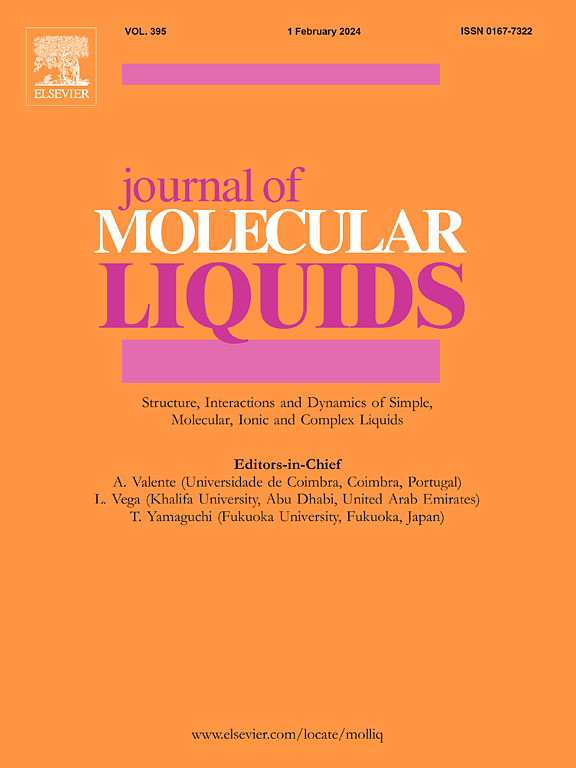Synthesis of bi-functional lignocellulosic adsorbent: Application for the simultaneous removal of cationic and anionic dyes
IF 5.3
2区 化学
Q2 CHEMISTRY, PHYSICAL
引用次数: 0
Abstract
The treatment of water polluted by mixed harmful compounds through minimal steps for treatment costs and environmental footprint reduction purposes, is an actual concern. In the present work, a bifunctional adsorbent capable of removing both cationic and anionic pollutants in aqueous medium was prepared by controlled grafting of a quaternary ammonium functionalized compound (Glycidyltrimethylammonium chloride (GTAC)) on sawdust. In order to facilitate the controlled grafting, the functionalization was performed in the ionic liquid solvent named (1-butyl-3-methylimidazolium chloride). Adsorbent characterizations by 13C NMR, points of zero charge determination and adsorption of model ionic compounds, confirmed the effective grafting of GTAC. The adsorbent was successfully applied to the simultaneous adsorption of a cationic dye (methylene blue (MB)) and an anionic dye (Orange (II) (O (II))). A synergistic effect favors the adsorption of the anionic dye to the detriment of the cationic dye due to the decrease of the negative charge of the lignocellulosic backbone. This was confirmed by thermodynamic studies, indicating stronger adsorption of the cationic dye (ΔH = −13.71 kJ/mol versus −8.42 kJ/mol for O(II)). The maximum adsorption capacities were less significant in simultaneous mode (79.7 µmol g−1 for O(II) and 37.7 µmol g−1 for MB) compared to the single mode (86.4 µmol g−1 for O(II) and 202.3 µmol g−1 for MB). The bifunctional sawdust exhibits high efficiency in real water samples and maintains relatively good performances even after five adsorption/desorption cycles.
双功能木质纤维素吸附剂的合成:在同时去除阳离子和阴离子染料中的应用
通过最小的步骤来处理被混合有害化合物污染的水,以降低处理成本和减少环境足迹,是一个实际关注的问题。采用季铵盐功能化化合物甘三甲基氯化铵(GTAC)在木屑上接枝的方法,制备了一种能去除水中阳离子和阴离子污染物的双功能吸附剂。为了便于控制接枝,在离子液体溶剂(1-丁基-3-甲基咪唑氯)中进行了功能化反应。通过13C核磁共振、零电荷点测定和模型离子化合物的吸附对吸附剂进行了表征,证实了GTAC的有效接枝。该吸附剂成功地应用于同时吸附阳离子染料(亚甲基蓝(MB))和阴离子染料(橙(II) (O (II))。由于木质纤维素主链负电荷的减少,协同作用有利于阴离子染料的吸附,而不利于阳离子染料的吸附。热力学研究证实了这一点,表明阳离子染料的吸附更强(ΔH =−13.71 kJ/mol,而O(II)为−8.42 kJ/mol)。同时模式下的最大吸附量(O(II)为79.7µmol g−1,MB为37.7µmol g−1)比单模式下的最大吸附量(O(II)为86.4µmol g−1,MB为202.3µmol g−1)不显著。双功能木屑在实际水样中表现出较高的效率,即使经过5次吸附/解吸循环也能保持较好的性能。
本文章由计算机程序翻译,如有差异,请以英文原文为准。
求助全文
约1分钟内获得全文
求助全文
来源期刊

Journal of Molecular Liquids
化学-物理:原子、分子和化学物理
CiteScore
10.30
自引率
16.70%
发文量
2597
审稿时长
78 days
期刊介绍:
The journal includes papers in the following areas:
– Simple organic liquids and mixtures
– Ionic liquids
– Surfactant solutions (including micelles and vesicles) and liquid interfaces
– Colloidal solutions and nanoparticles
– Thermotropic and lyotropic liquid crystals
– Ferrofluids
– Water, aqueous solutions and other hydrogen-bonded liquids
– Lubricants, polymer solutions and melts
– Molten metals and salts
– Phase transitions and critical phenomena in liquids and confined fluids
– Self assembly in complex liquids.– Biomolecules in solution
The emphasis is on the molecular (or microscopic) understanding of particular liquids or liquid systems, especially concerning structure, dynamics and intermolecular forces. The experimental techniques used may include:
– Conventional spectroscopy (mid-IR and far-IR, Raman, NMR, etc.)
– Non-linear optics and time resolved spectroscopy (psec, fsec, asec, ISRS, etc.)
– Light scattering (Rayleigh, Brillouin, PCS, etc.)
– Dielectric relaxation
– X-ray and neutron scattering and diffraction.
Experimental studies, computer simulations (MD or MC) and analytical theory will be considered for publication; papers just reporting experimental results that do not contribute to the understanding of the fundamentals of molecular and ionic liquids will not be accepted. Only papers of a non-routine nature and advancing the field will be considered for publication.
 求助内容:
求助内容: 应助结果提醒方式:
应助结果提醒方式:


